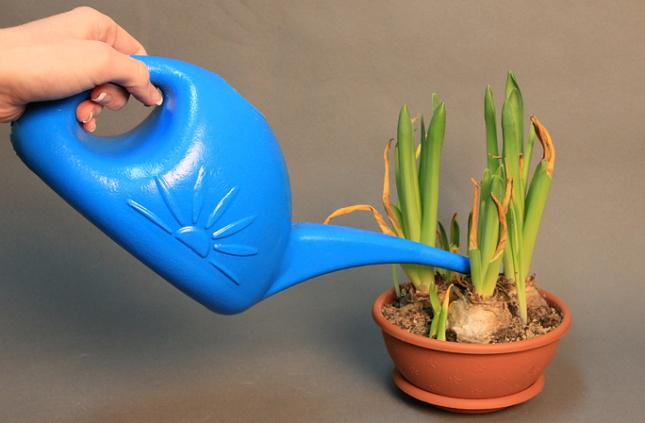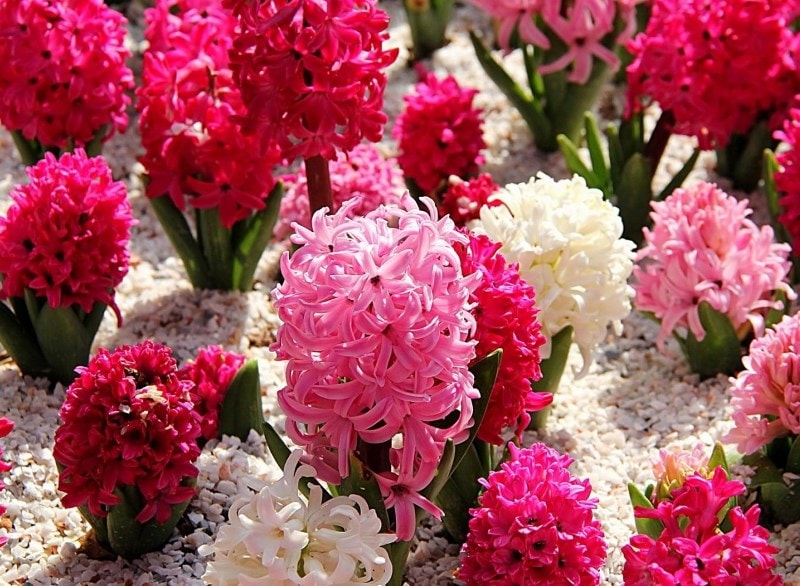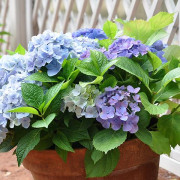When to dig up hyacinths after flowering
Content:
Hyacinth is a perennial plant belonging to the Asparagus family. Its leaves are dense, long, small flowers at the top form voluminous tassels. They are distinguished by a variety of colors: there are blue, pink, lilac, red and yellow hyacinths. The plant reproduces by bulbs, they are dense, have a round shape. Previously, it was attributed to the Liliaceae family, which includes tulips.
The need for annual digging of hyacinths
Perennial hyacinth bulb. It is able to function for 10 years. After this period, flowering stops, and usually new planting material is used.
Whether it is necessary to dig hyacinths for the winter is determined by environmental conditions. In the southern regions, characterized by a warm climate, the flower can not be touched, leaving it to winter in the ground. But this can lead to a deepening of the bulb. At the same time, attempts to reach it can lead to damage. Also, ignoring digging will affect flowering. It will not necessarily disappear, but it will not be as lush and colorful.
The conditions of the middle lane require the hyacinth to be dug every year. This is necessary in order to:
- eliminate the possibility of decay;
- protect from rodents and other pests;
- ensure abundant flowering in the future.
Digging up the bulbs for storage
By the appearance of a hyacinth, you can determine its readiness for digging. After flowering, the bulb continues to receive the nutrients it needs to grow.
When to dig up hyacinths:
- several weeks have passed after flowering;
- leaves wither, turn yellow.
Dead plant parts must be removed. This will eliminate decay and save the energy needed to maintain the life of wilted leaves. At the same time, you must carefully dig up the onion. Then follow simple steps:
- cleanse the earth;
- inspect for damage and rotten areas;
- put in a warm room for 2-3 days;
- remove dried roots and husks.
Optimal digging time
Hyacinth is usually dug up in June-July. The main thing is not to start the process ahead of time. Otherwise, the plant may not bloom next year.
The bulbs must gain strength, since there is a dormant period ahead, which the plant is experiencing without soil. For example, in the Moscow region, hyacinths bloom in the first half of May. Therefore, the optimal time for digging is at the end of June.
If, after flowering, the leaves remain healthy for a long time, this will have a beneficial effect on the plant. This means that it will receive more nutrients. Therefore, they usually continue to pay attention to the hyacinth and take care of it. Fertilizers applied to the soil will help preserve nutrients and prepare for a dormant state. At the same time, watering is gradually reduced.
If the plant has bloomed again, then digging is usually postponed, waiting for the end of the colorful period. After the end of flowering, the arrow is removed so that the plant does not waste energy on the formation of seeds. Therefore, there is no need for a box. This will help retain more of the nutrients needed at rest.
Bulb extraction rules
When it comes time to dig up hyacinths and tulips, you need to be careful. the main thing – do not harm the flower, remove it from the soil carefully, following simple rules:
- Be sure to wait for clear, sunny weather; on rainy days, it is better to refuse the procedure;
- If the hyacinth grows outdoors, use a pitchfork or bayonet shovel. In this case, it is better to take the land with a margin, so as not to damage the plant. It is better to drip to a depth of 30-45 centimeters. When cultivation is carried out in a pot, the tubers are shaken out of it;
- All bulbs, large and small, are removed from the soil. They are called babies. It is necessary to carefully check if there are any plant parts left in the ground;
- The onion is cleaned from soil and sent for drying in a ventilated room. The temperature is kept within 20 degrees. A week later, the planting material is prepared for storage.
Precautionary measures
It is important to dig up the hyacinth until the leaves die off completely. Otherwise, it will be difficult to find them in the ground. Dry foliage will break, bulbs will get lost. Digging without landmarks is fraught with damage to the plant.
Processing after digging
After removing the bulbs, it is recommended to rinse them under running water. It should be cool, no higher than 18 degrees. Then the plant needs to be pickled. To do this, keep in warm water for 10-15 minutes. Its temperature should be about 50 degrees. There are also special solutions as an alternative method. For example, Karbofos, the active ingredient of which kills harmful insects, has disinfectant properties. Half an hour in solution (3%) will help disinfect the flower. You can also use a weak solution of potassium permanganate, which has a disinfecting effect.
Bulbs storage rules
After the tubers are dry, they are peeled off. At the same time, they act carefully, because under it there may be children of the plant. They are separated from the main bulb. Then all the material for transplanting is transferred to a box. The entire dormant period of the plant lasts three months. It is important to provide comfortable conditions in order to maintain the health of the tubers, not to harm them.
The first month of maintenance requires coolness, the temperature should not exceed 20 degrees. Then the bulbs are transferred to a warmer room. The main thing is that it is well ventilated. At the same time, the temperature is maintained in the range from 25 to 27 degrees. So the plant is stored for another two months. At the same time, they carefully monitor the tubers so that they do not dry out, otherwise they will die or cannot take root. To do this, they are periodically sprayed with water.
If babies appear on the bulbs during the dormant period, it is recommended not to place them in open ground immediately. Better to give them time to grow stronger by planting them in pots. At first, they grow at home like houseplants. After several years, they can be transplanted onto the street. This usually happens after 3-4 seasons.
Transplanting hyacinths after flowering
You need to replant the plant in the fall (we are talking about warm regions that do not require digging out the bulbs for the winter). The most suitable period is from mid-September to early October. The hyacinth should have time to take root after planting. If the procedure is carried out later, he may not have time to develop the root system until the cold weather. Planting earlier will cause the flower to grow faster in a warm environment. By the onset of cold weather, the first entrances will appear, which will die on frosty nights.
When planting, the ground should have a temperature in the range of 7 to 13 degrees. You need to adhere to the rules so as not to harm the plant and maintain its health:
- 2-3 weeks before the planned planting, you need to prepare the ground, dig up and apply fertilizer;
- If necessary, reduce the acidity of the soil so that the plant is comfortable. The easiest way is to add chalk to the soil. Only then can you plant;
- Leave a distance of at least 8 centimeters between flowers. When using small bulbs, the distance is reduced;
- You need to plant tubers to a depth of about 12 centimeters. A small layer of river sand is placed at the bottom of the hole;
- Empty places are filled with soil and watered;
- They insulate plants for the winter. For this, the beds are covered with straw, sawdust, some use fallen leaves. You can use spruce branches and peat. With the onset of spring, the plants need to be opened. The signal for this is the melting of snow.
Proper care, timely digging of bulbs, comfortable conditions during rest will reward with abundant flowering. In the spring, the garden will be filled with aroma, the plants will sparkle with different colors.
If hyacinths of the same variety are planted, then you need to place the tubers at an equal depth and select by size. Then they will bloom at the same time. Simple rules will allow you to enjoy the abundant flowering of one bulb for at least 10 years.
Video




















